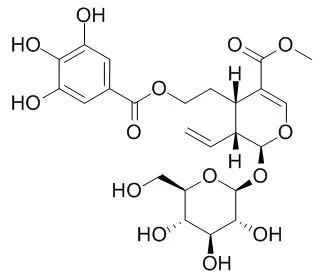| Kinase Assay: |
| Biol Pharm Bull. 2011;34(7):959-66. | | Cornuside suppresses lipopolysaccharide-induced inflammatory mediators by inhibiting nuclear factor-kappa B activation in RAW 264.7 macrophages.[Pubmed: 21719998] | Cornuside, a secoiridoid glucoside compound, was isolated from the fruit of Cornus officinalis SIEB. et ZUCC. Cornuside has been reported to possess immunomodulatory and anti-inflammatory activities. However, the effects and mechanism of action of Cornuside in inflammation have not been fully characterized.
METHODS AND RESULTS:
The present study was therefore designed to examine whether Cornuside suppresses inflammatory response in lipopolysaccharide (LPS)-stimulated RAW 264.7 macrophage cells. Cornuside significantly inhibited the LPS-induced production of nitric oxide, prostaglandin E(2), tumor necrosis factor-alpha, interleukin-6 (IL-6), and IL-1beta. The mRNA and protein expressions of inducible nitric oxide synthase (iNOS) and cyclooxygenase-2 (COX-2) were also decreased by Cornuside. Furthermore, Cornuside significantly attenuated the LPS-stimulated phosphorylation and degradation of inhibitory kappa B-alpha and the subsequent translocation of the p65 subunit of nuclear factor-kappa B (NF-κB) to the nucleus. Cornuside also reduced the phosphorylations of extracellular-signal-related kinase (ERK1/2), p38, and c-Jun N-terminal kinase (JNK1/2).
CONCLUSIONS:
These results suggest that the anti-inflammatory property of Cornuside is related to the downregulations of iNOS and COX-2 due to NF-κB inhibition as well as the negative regulation of ERK1/2, p38, and JNK1/2 phosphorylations in RAW 264.7 cells. | | Pharmacology. 2009;84(3):162-70. | | Cornuside attenuates apoptosis and ameliorates mitochondrial energy metabolism in rat cortical neurons.[Pubmed: 19696522] | Cornuside, a secoiridoid glucoside compound, was isolated from the fruit of Cornus officinalis Sieb. et Zucc.
METHODS AND RESULTS:
The present study elucidates the effects of Cornuside on cultured rat cortical neuron damage induced by oxygen-glucose deprivation. The results show that Cornuside treatment obviously attenuates apoptosis and ameliorates mitochondrial energy metabolism in rat cortical neurons by increasing the cell survival rate, mitochondrial antioxidant enzyme activities, mitochondrial respiratory enzyme activity, mitochondrial respiratory control ratio and the ATP content, and by decreasing the mitochondrial malondialdehyde content, lactate dehydrogenase leakage rate, intracellular Ca(2+) level and caspase-3 activity in a concentration-dependent manner.
CONCLUSIONS:
These findings indicate that Cornuside has protective potential against cerebral ischemic injury, and its protective effects may be due to the suppression of intracellular Ca(2+) elevation and caspase-3 activity, and improvements in mitochondrial energy metabolism and antioxidant properties. |
|
| Animal Research: |
| Planta Med. 2009 May;75(6):614-9. | | Effect of cornuside on experimental sepsis.[Pubmed: 19263342] | This study was conducted to investigate the efficacy of Cornuside, a secoiridoid glucoside compound, in cultured macrophages as well as in an experimental model of sepsis induced by cecal ligation and puncture (CLP) in rats.
METHODS AND RESULTS:
Cornuside was added to cultured macrophages at different concentrations, and all CLP rats were randomized to receive an intravenous injection of the corresponding drug followed by observation of its antisepsis effect. Our results showed that Cornuside downregulated the levels of TNF- alpha, IL-6, and NO production in a dose-dependent manner in activated macrophages, while it upregulated the level of IL-10. Intravenous injection of Cornuside or imipenem alone or in combination reduced CLP-induced lethality in rats after CLP. In addition, serum levels of TNF- alpha, IL-6, triggering receptor expressed on myeloid cells, and endotoxin were downregulated. On the other hand, the serum levels of IL-10 were upregulated. Decreased bacterial counts in blood, peritoneum, spleen, liver, and mesenteric lymph nodes and decreased myeloperoxidase in lung, liver, and small intestine also were found after Cornuside injection.
CONCLUSIONS:
These data indicate that the antisepsis therapeutic effect of Cornuside is mediated by decreased local and systemic levels of a wide spectrum of inflammatory mediators. This work provides first evidence for the clinic use of Cornuside as a new immunomodulatory drug that has the capacity to inhibit the inflammatory response in sepsis. |
|






 Cell. 2018 Jan 11;172(1-2):249-261.e12. doi: 10.1016/j.cell.2017.12.019.IF=36.216(2019)
Cell. 2018 Jan 11;172(1-2):249-261.e12. doi: 10.1016/j.cell.2017.12.019.IF=36.216(2019) Cell Metab. 2020 Mar 3;31(3):534-548.e5. doi: 10.1016/j.cmet.2020.01.002.IF=22.415(2019)
Cell Metab. 2020 Mar 3;31(3):534-548.e5. doi: 10.1016/j.cmet.2020.01.002.IF=22.415(2019) Mol Cell. 2017 Nov 16;68(4):673-685.e6. doi: 10.1016/j.molcel.2017.10.022.IF=14.548(2019)
Mol Cell. 2017 Nov 16;68(4):673-685.e6. doi: 10.1016/j.molcel.2017.10.022.IF=14.548(2019)